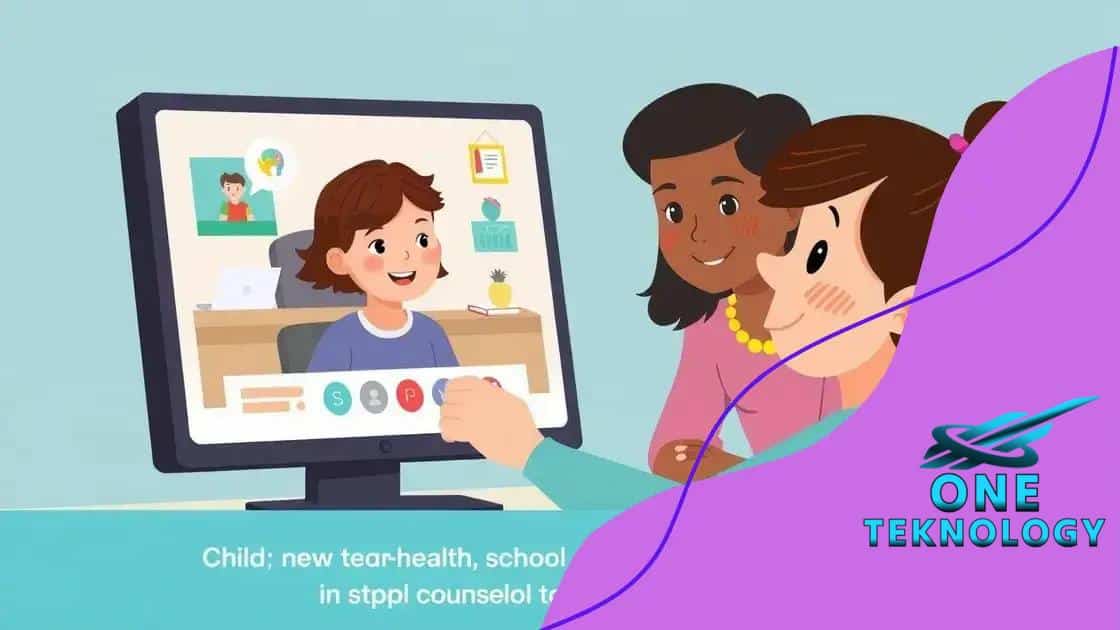Expanding access to mental health services for children

Expanding access to mental health services for children is critical, addressing barriers such as stigma and cost, while promoting innovative solutions like telehealth and school-based programs that enhance support and advocacy.
Expanding access to mental health services for children is crucial for ensuring healthy development. Have you ever wondered how this initiative could impact your own community? Let’s explore the transformative potential of these services.
The importance of mental health for children
Mental health is essential for children, just as physical health is. When children are mentally healthy, they can learn better, build strong relationships, and thrive in their daily lives. The importance of mental health for children cannot be overstated, as it lays the foundation for their overall well-being.
Understanding Mental Health
Mental health encompasses emotional, psychological, and social well-being. It affects how children think, feel, and act. Good mental health helps children handle stress, relate to others, and make choices. Recognizing signs of mental health issues early on is crucial.
Common Mental Health Issues in Children
- Anxiety disorders
- Depression
- Behavioral disorders
- Learning disabilities
These conditions can impact a child’s ability to learn and interact with peers. Many children face these challenges, yet only a few get the help they need. This gap highlights the importance of awareness and early intervention.
Why Mental Health Matters
A strong mental foundation enables children to engage fully in life. Research shows that children with positive mental health perform better academically and develop healthier relationships. Furthermore, addressing mental health issues fosters resilience, making children more adaptable in facing life’s challenges.
Involving parents, educators, and healthcare providers is crucial in supporting children’s mental health. Creating a nurturing environment at home and school allows children to express their feelings and seek help when needed.
Promoting Mental Wellness
There are various ways to promote mental health among children:
- Encourage open communication about feelings
- Teach stress management skills
- Provide a safe and supportive environment
- Incorporate mindfulness practices into daily routines
These strategies can lead to improved emotional regulation and coping skills, allowing children to enjoy their childhood and grow into healthy adults.
By prioritizing mental health, we not only improve individual lives but also strengthen communities. Investing in children’s mental well-being pays off in the long term.
Barriers to accessing mental health services
Accessing mental health services is vital for children, yet many face significant obstacles. Understanding barriers to accessing mental health services is essential to create solutions that help families get the support they need.
Common Barriers
There are several factors that can prevent children from receiving mental health care. Many families struggle with understanding where to find help. They may not know the services available or how to navigate the mental health system. Cost can be another significant concern, as many families cannot afford therapy or counseling sessions.
- Stigma: Many people still view mental illness negatively, which can make families hesitant to seek help.
- Lack of Awareness: Some parents may not recognize the signs of mental health issues in their children.
- Geographic Barriers: In rural areas, mental health services may be limited or non-existent.
- Limited Insurance Coverage: Many health insurance plans provide inadequate coverage for mental health services.
Understanding these barriers is the first step towards addressing the needs of children. It is important for communities to work together to break down these obstacles.
Creating Solutions
By raising awareness about mental health issues and the resources available, communities can support families in accessing care. Schools play a crucial role in this effort by collaborating with mental health professionals to provide information and resources to students and parents alike.
Building relationships with healthcare providers is also important. Parents should feel comfortable discussing their concerns with doctors, who can guide them to appropriate resources and services for their children. Schools can help facilitate this connection, providing a bridge between families and healthcare.
Innovative solutions for improving access

Access to mental health services for children is a pressing issue. Fortunately, there are innovative solutions for improving access that can make a difference. These solutions aim to bridge gaps and ensure that every child can receive the support they need.
Telehealth Services
One effective way to increase access is through telehealth. This allows children to receive therapy and mental health support from the comfort of their home. Telehealth eliminates transportation barriers and can be especially beneficial for families living in remote areas.
- Convenient appointments reduce missed sessions.
- Access to specialists who may not be available locally.
- Privacy and comfort for children during therapy.
Utilizing technology not only increases accessibility but also helps destigmatize seeking help.
School-Based Mental Health Programs
Another impactful solution is to implement mental health programs directly in schools. This integration helps identify children in need and provides immediate support. Trained counselors and therapists can offer services on-site, making it easier for children to access help without leaving their school environment.
Educators can also be trained to recognize mental health issues and refer students to resources. This proactive approach helps in addressing problems early, ensuring that children get the assistance they require before issues escalate.
Community Partnerships
Building partnerships between schools, mental health organizations, and community groups can also enhance access to mental health services. These collaborations can lead to:
- Resource sharing among organizations.
- Increased awareness of available services.
- Support groups and workshops for families.
Community efforts ensure a holistic approach to mental health, providing a network of support that extends beyond individual therapy.
Finding ways to remove barriers and enhance access not only supports children’s mental health but also fosters a healthier community overall. Each innovative solution contributes to better outcomes and a brighter future for all children.
Role of schools in mental health support
Schools play a vital role in supporting children’s mental health. They are often the first place where signs of mental health issues are observed. The role of schools in mental health support cannot be underestimated, as they provide essential resources and a structured environment for children to thrive.
Identifying Mental Health Issues
Teachers and school staff are usually in a unique position to notice changes in a child’s behavior. Early identification can lead to timely interventions. Therefore, training educators to recognize mental health signs is crucial. By being observant, they can help children get the support they need quickly.
- Training staff in mental health awareness.
- Creating a supportive atmosphere where students feel safe to express concerns.
- Implementing screenings to identify issues early.
Such measures can significantly impact a child’s future well-being.
Providing Counseling Services
Many schools now offer counseling services directly on campus. These counselors help students navigate their emotions and mental health challenges. Access to a professional during school hours can make it easier for children to seek help.
Moreover, when counselors conduct workshops on topics like stress management and mindfulness, they equip students with essential coping skills. This proactive support allows children to manage their challenges effectively, promoting a healthier school environment.
Building Partnerships with Parents and Community
Schools can enhance mental health support by collaborating with parents and local mental health organizations. Regular communication between schools and families helps parents understand available resources. When schools host workshops and informational sessions, they create a stronger community support system.
These collaborations ensure families know how to access additional help if needed. They also foster a culture of openness regarding mental health, encouraging students to seek assistance without fear of stigma.
As schools continue to prioritize mental health, they affirm their commitment to the holistic development of every child.
How parents can advocate for their children
Parents play a crucial role in advocating for their children’s mental health needs. Understanding how parents can advocate for their children is essential to ensure they receive the necessary support. In many instances, parents are the key link between their children and various services available.
Knowing Your Child’s Needs
The first step in advocacy is knowing your child’s unique strengths and challenges. Regularly communicating with them about their feelings can help parents identify any emerging mental health issues. Open discussions about emotional well-being create a foundation for support.
- Listen to your child without judgment.
- Encourage them to express their feelings.
- Observe behavioral changes or struggles they might face.
By understanding their children’s needs, parents can address issues proactively.
Engaging with Schools
Parent advocacy includes active engagement with teachers and school counselors. Attending school meetings and discussing concerns with educators fosters a strong partnership that benefits the child. Parents should communicate clearly and assertively about their child’s needs and support them within the school environment.
Education professionals can provide valuable insights into the child’s performance and behavior in school. Additionally, parents can advocate for school-based mental health resources, encouraging schools to implement programs that support emotional well-being.
Connecting with Community Resources
Many organizations offer mental health resources for families. Parents should explore local community services that provide counseling, support groups, and education on mental health. Connecting with these resources can open doors for their children to access additional support.
Approaching advocacy as a collaborative process, parents can partner with community organizations to create awareness about mental health issues. By working together, families can help reduce stigma and promote the importance of mental health in their communities.
Advocacy is an ongoing effort that gives parents a voice in their child’s mental health journey. By understanding their role and actively participating, parents can ensure their children receive the best support possible.
In conclusion, expanding access to mental health services for children is essential for their well-being. By understanding the importance of mental health, removing barriers, and exploring innovative solutions, we can create supportive environments that nurture young minds. Parents, schools, and communities must work together to ensure every child has access to the help they need. Through advocacy and collaboration, we can make a meaningful impact on children’s mental health.
FAQ – Frequently Asked Questions about Expanding Access to Mental Health Services for Children
What are some common barriers to accessing mental health services for children?
Common barriers include stigma, lack of awareness, cost of services, and limited availability of resources in certain areas.
How can schools support children’s mental health?
Schools can provide counseling services, identify mental health issues early, and create supportive environments for students.
What role do parents play in advocating for their children’s mental health?
Parents can advocate by understanding their child’s needs, engaging with schools, and connecting with community mental health resources.
What innovative solutions are available to improve access to mental health services?
Innovative solutions include telehealth services, school-based mental health programs, and community partnerships that enhance resource availability.






